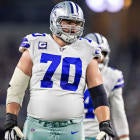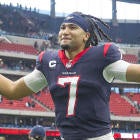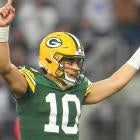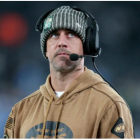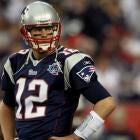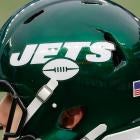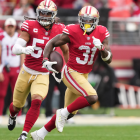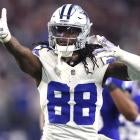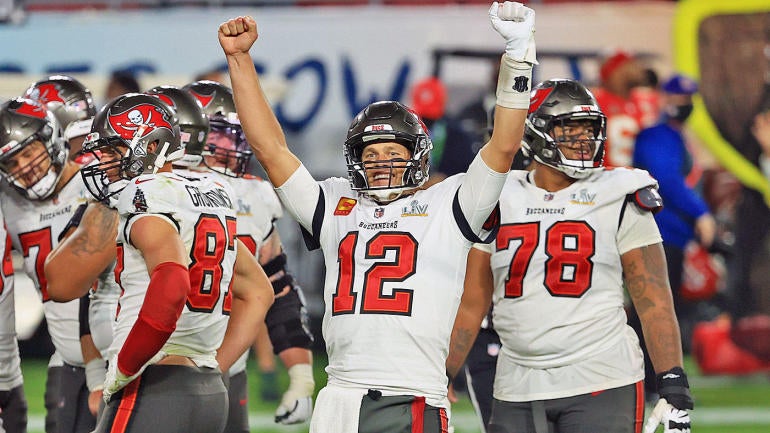
The NFL, as we hear every year after the Super Bowl, is a copycat league. More often than not, teams will emulate the Super Bowl champion as they try to build out their organization. Winning the Lombardi Trophy is the ultimate goal, so why not steal ideas from the team that actually does it?
This year, the Tampa Bay Buccaneers provided a bunch of important lessons in team building, but so did their opponents, the Kansas City Chiefs. Below, we'll walk through a few ideas teams around the league can take away from the two teams that squared off in the Super Bowl.
The quarterback is everything...
The 2019 Buccaneers were a pretty good team.
They finished the season with one of the league's best defenses, ranking sixth in Football Outsiders' DVOA, with the No. 13-ranked unit against the pass and the top-ranked group against the run. They even ranked sixth in yards allowed per play, eighth in the percentage of opponent drives that ended in a turnover, fifth on third downs, and seventh in red-zone scoring rate. They had a pretty good offense, too, finishing the year third in both yards and points, sixth in yards per play, and 10th in the percentage of drives that ended in a score.
There was, of course, one big problem: they couldn't stop turning the ball over. Specifically, Jameis Winston couldn't. While Winston threw for a league-leading 5,109 yards and 33 touchdowns, he also tossed an NFL-high 30 interceptions and fumbled 12 times. As a result, the Bucs turned it over on 20.2 percent of their possessions -- the fifth-highest turnover rate any team posted in the previous 15 years. Because Winston couldn't stop giving the ball away, Tampa's opponents had the third-best average starting field position in the league, and they had to travel far less distance to score -- even against a top defense. So despite ranking strongly in several underlying metrics, the Bucs allowed more points than all but three other teams.
Fast forward to 2020. The Bucs again had one of the league's top defenses, ranking fifth in DVOA, with the No. 5-ranked unit against the pass and the top-ranked group against the run. They ranked sixth in yards allowed per play, and third in the percentage of opponent drives that ended in a turnover. Their offense racked up yards (seventh) and points (third) just like it did in 2019, and ranked sixth in the league in the percentage of their drives that ended in a touchdown or field goal.
The difference, of course, was the quarterback. Where Winston threw 30 interceptions and fumbled 12 times, Tom Brady tossed just 12 picked and fumbled four times. Brady's ability to take care of the ball dropped Tampa's team turnover rate to 8.9 percent of possessions -- the sixth-lowest rate in the league. As a result, they went from being a middle-of-the-pack offense in terms of their efficiency to a top-three unit. Pair that with their still-elite defense, and it's no surprise the Bucs were one of the best teams in the league. Sometimes, it really is that simple.
...as long as your offensive line is healthy
Of course, your quarterback is only as good as the guys in front of him -- no matter how skilled he is. Just take a look at what happened in the Super Bowl, where Brady was incredibly well protected while Patrick Mahomes spend most of the evening running for his life.
Here are the path's that Patrick Mahomes (top) and Tom Brady (bottom) took before pass attempts in shotgun during tonight's #SuperBowl
— Michael Lopez (@StatsbyLopez) February 8, 2021
Red: complete
White: incomplete pic.twitter.com/TLFEOxzwhr
The Chiefs played the Super Bowl without both of their starting tackles. Mitchell Schwartz went down around midseason with a back injury, while Eric Fisher suffered an Achilles injury during the AFC title game.
While Mike Remmers played adequately in Schwartz's stead on the right side, he was a bit of a mess on the left, and Andrew Wylie (normally a starting guard) was overmatched when kicked outside to right tackle. Those injuries allowed Tampa's edge rushers to dominate the game, just as they did in the NFC Championship against the Packers, who were without starting left tackle David Bakhtiari.
Tampa's offensive line, meanwhile, was one of the best in the league throughout the season -- particularly in pass protection. Donovan Smith had arguably the best season of his career. Ali Marpet and Ryan Jensen were dominant on the inside. Rookie Tristan Wirfs solidified the right tackle spot. Even after the injury to Alex Cappa, this group kept right on going as a top-flight unit, providing Brady the infrastructure he needed to succeed.
When paying up for pass rushers, make sure you're right
Before the 2019 season, the Chiefs made a big move to upgrade on the edge. They traded their 2019 first- and third-round picks, plus a 2020 second-rounder, to the Seattle Seahawks in exchange for Frank Clark and a 2019 third-rounder. They also signed Clark to a monster extension, handing him a five-year deal worth $105.5 million, with $63.5 million in guarantees.
Clark, then 25, was coming off a tremendously productive three-season stretch during which he had 32 sacks, 31 tackles for loss, and 66 quarterback hits. Look what's happened since he arrived in Kansas City, though.
| Year | Team | Games | Sacks | Tackles | Solo | Assist | TFL | Hits |
|---|---|---|---|---|---|---|---|---|
| 2015 | SEA | 15 | 3.0 | 16 | 15 | 1 | 4 | 6 |
| 2016 | SEA | 15 | 10.0 | 47 | 25 | 22 | 11 | 18 |
| 2017 | SEA | 16 | 9.0 | 32 | 19 | 13 | 10 | 21 |
| 2018 | SEA | 16 | 13.0 | 41 | 33 | 8 | 10 | 27 |
| 2019 | KAN | 14 | 8.0 | 37 | 27 | 10 | 12 | 14 |
| 2020 | KAN | 15 | 6.0 | 29 | 21 | 8 | 8 | 15 |
Clark went from averaging 58.3 pressures per season during his final three years in Seattle, per Pro Football Focus, to averaging just 45.5 per year in Kansas City. That is a major, major drop-off for a player being paid like Clark is, where he is getting the kind of money that is supposed to ensure a team an elite pass rush.
While Clark had a $19.3 million cap hit in 2020 and is set to count for $25.8 million against the books in 2021, consider what the Buccaneers got out of Shaquill Barrett ($15.8 million) and Jason Pierre-Paul ($12.8 million). That duo combined for 17 regular-season sacks, 30 hits, and 125 pressures. (Barrett led all edge rushers with 77, while JPP added 48.) They were so productive that even though the Bucs lost interior star Vita Vea for most of the season, the team's defense didn't really miss a beat. It's hard to imagine the same happening if Chris Jones missed time for Kansas City.
Don't pay up for running backs (again)
Just look at what these two teams got out of their respective running games in the Super Bowl.
The Chiefs could barely rely on Clyde Edwards-Helaire -- their first-round pick in the 2020 NFL Draft -- to do much of anything, while the Bucs got 125 yards and a touchdown on Leonard Fournette's 20 total touches. Fournette, by the way, was available for nothing the week before the season started, and played behind Ronald Jones for most of the year.
There was a lot made of how it was alright for Kansas City to take a running back in the first round despite all available evidence that it is a poor use of resources, due to Edwards-Helaire's perfect fit for the offense and game-breaking talent. But he underwhelmed during the regular season and looked like the team's second-best back for most of the playoffs. Former college teammate Darrel Williams -- an undrafted free agent -- outplayed him when on the field. Fournette was a former No. 4 overall pick who, again, became available shortly before the start of the season. And the guy that replaced him in Jacksonville (undrafted free agent James Robinson) gave the Jags significantly more than Fournette ever did.
It's just not worth it to pay up (or use a premium pick) at a position where production can be found for so little investment.
When all else fails, change your plan
As we wrote last week, the Bucs got torched by the Chiefs in the teams' first matchup of the season.
Mahomes completed 37 of 49 passes for 462 yards and three touchdowns. Tyreek Hill hauled in 13 of 15 targets for 269 yards and was on the receiving end of all three of Mahomes' scores...
Early in the game, the Bucs tried to use a bunch of single-high safety looks (Cover-1 and Cover-3), and the Chiefs beat them. Later in the game, they went to more Cover-2 and Cover-4, and the Chiefs beat them. Poor Carlton Davis got tasked with following Hill wherever he went on the field for most of the game, and got absolutely roasted the entire afternoon. No matter what changes Tampa made, Mahomes and Hill had an answer.
The more passive strategy the Bucs used in the second half wasn't limited to their coverages. They also blitzed far less often after the break. Mahomes lit up their blitzes by going 5 of 8 for 86 yards and a touchdown in the first half, so Todd Bowles only sent one blitz in the second half. It didn't much matter. When Tampa sat back in soft zones, he just continually found Travis Kelce on underneath routes. The Chiefs repeatedly took advantage of Kelce being matched up on a linebacker or safety in space, where the Bucs just had no hope of containing him.
In the rematch, the Bucs took their second-half strategy and used it pretty much all game. In an out-of-character move, they hardly blitzed Mahomes at all. They played almost exclusively two high safeties, daring the Chiefs to keep throwing short and over the middle, while consistently getting pressure despite rushing only four. This, again, was extremely out of character for a Todd Bowles-led defense.
How did Todd Bowles & Co. design the perfect defensive game plan to limit the big-play ability of Patrick Mahomes and the Chiefs' offense? A THREAD ⬇️
— Next Gen Stats (@NextGenStats) February 8, 2021
🔹 (I) Two-high safety shells
🔹 (II) Pressure w/o blitzing
🔹 (III) Take away the sidelines#SBLV | #GoBucs pic.twitter.com/BW4ruwwBkY
(I) Two-High Safety Shells
— Next Gen Stats (@NextGenStats) February 8, 2021
The Buccaneers' defense aligned in a two-high safety shell on 87% of plays (59 of 68 plays), the HIGHEST rate by a Todd Bowles-led defense in a game over the last five seasons.
🔹 Mahomes (Deep): 0/5, 0 yards, INT#SBLV | #GoBucs
(II) Pressure Without Blitzing
— Next Gen Stats (@NextGenStats) February 8, 2021
The Bucs blitzed on 9.6% of dropbacks, the LOWEST rate by a Bowles-led defense over the last five seasons.
🔹 4-Man Rush: 16 pressures, 34.0% QBP rate
*Bowles' three lowest blitz rates have all come against Andy Reid#SBLV | #GoBucs
Everything the Bucs wanted to do against the Chiefs in the first matchup backfired. Even though that was the game plan that made them successful -- that got them to the Super Bowl -- they changed it up for the rematch. If everything you do fails, there's no reason to go back to the well. You have to adapt. The Bucs did that, and now they're deserving champions.











